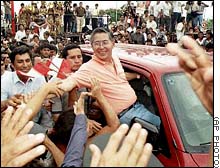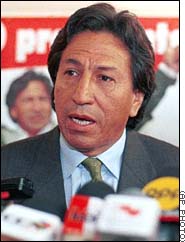 The
current president, Alberto Fujimori.
Blank Space
The
current president, Alberto Fujimori.
Blank Space
 The
current president, Alberto Fujimori.
Blank Space
The
current president, Alberto Fujimori.
Blank Space
l The
contender, Alejandro Toledo.
The
contender, Alejandro Toledo.
Military Involvement In Peruvian
Politics
Forunately, the two men above have not had to worry about guns pointing
at their heads during the current campaign. Peru has a long and storied
relationship with its military. Dating all the way back to the Incas,
who ruled with an iron fist, and the Spanish, who did likewise, the regionís
common peoples have been subjected to the whims of an elitist class which
uses military might to quell all opposition. General Juan Velasco
Alvarado (Yes, another Velasco) became the quintessential military dictator
in Peru.
Velasco overthrew an elected and comparatively well liked president
in Fernando Belaúnde Terry, whom had proven to be not so competent
in the act of running a nation. Velasco captured popular support
by calling for reform, reform, some more reform, and even more reform.
(Dietz 1980, 23). This seems to be a popular way to get ahead in
the region. He saw the Peruvian nation as a giant corporation, with
the military as CEO and the population as the little worker bees.
(Dietz 1980, 26). This way of looking at things helped him formulate
the plan to set up large scale beaurocracies, which would enable nothing
to ever actually occur, including him getting overthrown. Of course,
this plan would fail. The government did in fact actually get some
reforms accomplished. Amazing, considering all the beaurocracy.
In either case, Peru has remained remarkably stable and the military
has not been as nearly a large influence as in some countries (notably,
Ecuador and Bolivia). The present sees a democratically elected president
fighting a guerrilla war against a dwindling group of insurgents.
In fact, since Fujimoriís election in 1990, the country has remained comparatively
stable. Fujimori did not seize dictatorial powers; however, with
the rise of the Shining Path violent movement, he was able to use martial
law, thereby carrying on the great traditions of his highly militarized
predecessors like Velasco.
To continue the tour, click here.